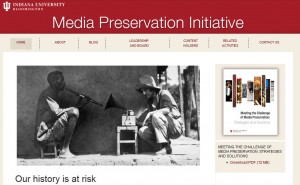Cornell AV in Bloom(ington)
In late October, we had the opportunity to visit members of Indiana University’s Media Preservation Task Force with two colleagues from Cornell’s Lab of Ornithology, Karl Fitzke (Audio Engineer at Macaulay Library), and Bill McQuay, (Supervising Audio Engineer, Macaulay Library). Our goal was to learn more about IU’s ambitious preservation plan to digitize its AV holdings comprehensively. Also in attendance was Adam Tovell, Preservation Officer for Sound and Moving Image Collections at the British Library, who is on the brink of developing a similar initiative for the BL. As it happens, our visit was very well-timed, as just a week prior the President of IU had announced a $15 million/5-year initiative to fund digital preservation for the entirety of the IU AV collections, campus-wide: http://news.iu.edu/releases/iu/university-wide/2013/10/state-of-university-2013.shtml
Over the course of two jam-packed days, we met with an impressive range of staff and departments collaborating closely to move the AV initiative forward. It was inspiring to get a first-hand look into their almost-decade-long effort to bring Indiana University into the forefront of AV preservation. Everything was carefully considered, thoroughly researched, and brilliantly executed. They have paved the way in setting international audio preservation standards (http://www.dlib.indiana.edu/projects/sounddirections/papersPresent/index.shtml – with Harvard University); developed tools to assess risk, uniqueness, and digitization workflows; and created a major new access platform with Northwestern University and Audio Visual Preservation Solutions called Avalon – https://wiki.dlib.indiana.edu/display/VarVideo/Avalon+Media+System .
Our visit included an overview of the history of the AV initiative, including administrative strategies, technical challenges, and approaches to data gathering. One of IU’s first steps in the process was to conduct what they called a “census” of all key stake-holders on campus, to determine the scope of the problem (number of items/formats; condition of materials; available metadata, etc). This was an effort conducted in person without the use of web surveys, and resulted in excellent data with which to plan the larger effort (some of the spreadsheets are dizzying). It was also a key part of relation-building to garner support for the initiative.
An early advocate of the effort included the Vice Provost for Research, who was the former Director of the Archive of Traditional Music (ATM), an incredibly rich repository of audiovisual material that documents music and culture from around the world. Not surprisingly, Indiana’s initiative originated from the ATM due to the large, rare, and unique collections of legacy media it contains. When faced with the possibility of losing holdings over time due to degradation and signal carrier (ie. playback equipment) obsolescence, they realized that something needed to happen sooner rather than later. Our discussions again confirmed the necessity of institutions to have a plan for this material in place or risk losing access to it forever. Mike Casey, head of the IU initiative, explained that most legacy AV material will not be accessible in 10-15 years, and tackling migration to digital formats gets more expensive by the day.
Another very impressive part of their effort was their institutional IT support. Working server space to support the digitization of the material is estimated to be roughly 200 terabytes. The estimated final total needed to archive the digitized material is around 13 petabytes, not including film. When they do include film content, the estimated total will be 49 petabytes. Film is widely considered to be more stable than magnetic media, so they’re approaching that issue separately, due to their vast, unique holdings and ideal storage conditions (which includes almost 3,000 titles in frozen storage). Astonishingly, the IT group appears unfazed by these numbers, with petabytes of storage already available for use.
In short, it was an inspiring visit, and we are ever-grateful for our generous hosts. It was also well-timed from Cornell’s perspective, as the campus-wide CU AV Preservation Group just got the green light from Anne Kenney, Ted Dodds, and Mike Webster to begin an exploratory pilot to determine the scope of the challenges here at Cornell. We will be unveiling a project plan in January, and are hoping for campus-wide engagement on this very challenging task. Find more information here:
https://confluence.cornell.edu/display/CAV/Home
Stay tuned…
Danielle & Tre


